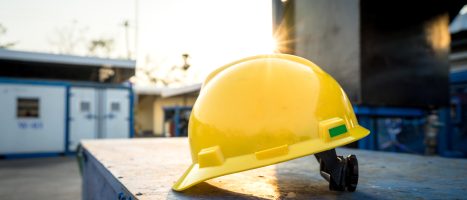Asbestos in Buildings
Asbestos has been used since the late 1800s, whether for fireproofing, soundproofing or insulation. Although asbestos has been around for quite some time, the health consequences were not widely talked about until the 1960s.
Asbestos makes a great insulator and on a job site where there are high stress equipment being operated, it is no secret that asbestos found its way onto the scene. Despite being exposed on the jobsite, workers are exposed at all stages of building. When they build the house they are at risk and once they live in the house they are at high risk. If a building was constructed prior to 1980s, there is a high likelihood of asbestos presence.
Construction Materials and Asbestos
Construction workers faced risks using most products needed on the job site day to day. Aside from being around the following products, construction workers often worked around high impact areas that disturbed the asbestos and caused the fibers to be released into the air. The most common construction products that contained asbestos include:
- Roofing
- Shingles and Siding
- Domestic Heaters and Stoves
- Floor Tiles
- Textured Paints
- Heat-Resistant Fabrics
- Spray-On Insulation
- Roofing Insulation
Get a Free Compensation Guide
Learn more about legal options for asbestos exposure victims and how to obtain compensation.
Get Your Free Guide NowTrust Funds for Construction Workers
There are many more manufacturers that produced asbestos products, however the companies listed below are the highest paying asbestos bankruptcy trusts for construction workers and their families. Construction workers or relatives can start here when looking to see if they qualify for compensation.
| Company | Average Payouts |
|---|---|
| DII Harbison Walker | $81,900.00 |
| North American Refractories Company | $75,000.00 |
| Pittsburgh Corning | $52,675.00 |
| WR Grace | $46,800.00 |
| United States Gypsum | $38,750.00 |
| Armstrong World Industries | $39,600.00 |
| Kaiser Aluminum | $27,650.00 |
| Owens Corning (Fibreboard) | $23,8650.00 |
Construction Products and Asbestos
Based on regulations put in place by the EPA, certain products can still contain up to 1% asbestos. Many construction products still contain asbestos because of this 1% rule, the exposure is just less potent as a result. On top of EPA regulations, OSHA has stepped in to put a great deal of workplace safety guidelines and procedures forward to help combat any remaining health risks. The following products likely still contain asbestos.
- Spray On Acoustic
- Floor Tile & Mastic
- Linoleum & Mastic
- Plaster & Paint
- Silver Duct Tape
- Pipe Covering
- Interior Plaster
- Elbow & Joint Packing
- Roofing Materials
- Vinyl Tile
- Imported Cement Pipe & Sheeting
- Gas Masks
- Textiles
- Cement Water Pipe
- Insulation
Exposure Risks for Construction Workers
The EPA put regulations in place to protect the public and workers in industries that faced higher rates of occupational exposure. The regulations often fell short for construction workers. Unfortunately for the construction industry, banning new asbestos products does not mean that old buildings and job sites necessarily become off limits.
During the transition years after stricter regulations came into play, many workers were still being exposed to asbestos via old building renovations and demolitions. When construction supplies were being installed, the fibrous asbestos was often disturbed which released these fibers into the air. Given the large amount of asbestos use pre-1981, this was happening at a high frequency.
Construction workers currently working, post-asbestos regulation, face exposure when they renovate or demolish buildings built pre-1981. This put thousands of workers at risk for asbestos related diseases, such as mesothelioma. As construction usually involves high impact and disruptive tasks, workers are constantly at risk of disturbing asbestos. Two studies covering construction workers’ death causes and specific mesothelioma cases, showed that of 2,242 workers’ cases looked at, 752 died from a disease thought to be linked to asbestos exposure.
Find Out if you Qualify
Fill out our quick form and see if you qualify for trust fund compensation
Check NowSources
- American Journal of Respiratory and Critical Care Medicine. (n.d.). Diagnosis and Initial Management of Nonmalignant Diseases Related to Asbestos. Retrieved from https://www.atsjournals.org/doi/full/10.1164/rccm.200310-1436ST
- Environmental Health Perspectives. (2004). Asbestos-induced peritoneal mesothelioma in a construction worker. Retrieved from https://www.ncbi.nlm.nih.gov/pmc/articles/PMC1241930/
- Europe PMC. (2009). Mesothelioma in construction workers: risk estimate, lung content of asbestos fibres, claims for compensation for occupational disease in the Veneto Region mesothelioma register. Retrieved from http://europepmc.org/article/MED/19382522
- OSHA. (2002). Asbestos Standard for the Construction Industry. Retrieved from https://www.osha.gov/Publications/osha3096.pdf
- Pacific Union College. (n.d.). SUMMARY OF ASBESTOS CONTAINING MATERIAL IN BUILDINGS AND BULK SAMPLE ANALYSIS.Retrieved from https://www.puc.edu/__data/assets/pdf_file/0008/74717/Summary-of-Asbestos-Containing-Material-in-Buildings.pdf
- U.S. Bureau of Labor Statistics. (2019). Occupational Employment and Wages, May 2019. Retrieved from https://www.bls.gov/oes/current/oes470000.htm
- Agency for Toxic Substances & Disease Registry. “Asbestos and Your Health”. Retrieved from https://www.atsdr.cdc.gov/asbestos


